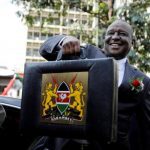Kenya‘s Finance Minister Henry Rotich said on Thursday he expected steady economic growth for this year as he presented the country’s last budget before a national election in August.
Growth is expected to be 5.9 percent in 2017, the same rate of expansion in the first three quarters of last year, he said.
“But growth could be lower if the ongoing drought persists and the slowdown in private sector credit is not reversed,” Rotich warned.
East Africa has been suffering from severe drought and aid groups say 2.7 million Kenyans need food aid.
Rotich set the fiscal deficit at 524.6 billion shillings ($5.10 billion) or 6 percent of the gross domestic product, down from 9 percent in the current fiscal year. He pledged to lower it further to 4 percent of GDP in the 2019/20 fiscal year.
“The plans for fiscal consolidation are the most positive of this budget,” said Armando Morales, the IMF’s resident representative in Kenya.
He however cautioned that the minister’s revenue projection could be a little too optimistic. The minister projected a 13 percent increase in revenue.
“It will be difficult to grow the revenue but we need to go through the details,” Morales told Reuters.
Rotich has set aside billions of shillings for infrastructure including railways and new roads, and increased welfare payments for senior citizens.
“The net external financing will amount to 256 billion or 2.9 percent of GDP and will be mainly on concessional terms,” Rotich told lawmakers.
The balance, 268.6 billion shillings or 3.1 percent of GDP, will be borrowed from the local market, he said.
The government is investigating the effects of a controversial cap on interest rates, which bankers say have frozen smaller lenders out of the market as banks invest in low-risk government bonds, the minister said.
After the government tightened banking regulations and introduced the cap, the growth of private sector credit slowed down to 4.5 percent last December, from 17 percent a year earlier, stoking concerns about the potential impact on growth.
The government would freeze in-house recruitment except for a few sectors, part of a promise to tackle the country’s ballooning wage bill, Rotich said in the budget.
President Uhuru Kenyatta, who is up for re-election in August’s parliamentary and presidential vote, has promised to slash politicians’ pay packages, which are among the highest in the world.
He has also dismissed opposition criticism of government borrowing, saying the money is funding an ambitious development agenda.
Kenya‘s Finance Minister Henry Rotich said on Thursday he expected steady economic growth for this year as he presented the country’s last budget before a national election in August.
Growth is expected to be 5.9 percent in 2017, the same rate of expansion in the first three quarters of last year, he said.
“But growth could be lower if the ongoing drought persists and the slowdown in private sector credit is not reversed,” Rotich warned.
East Africa has been suffering from severe drought and aid groups say 2.7 million Kenyans need food aid.
Rotich set the fiscal deficit at 524.6 billion shillings ($5.10 billion) or 6 percent of the gross domestic product, down from 9 percent in the current fiscal year. He pledged to lower it further to 4 percent of GDP in the 2019/20 fiscal year.
“The plans for fiscal consolidation are the most positive of this budget,” said Armando Morales, the IMF’s resident representative in Kenya.
He however cautioned that the minister’s revenue projection could be a little too optimistic. The minister projected a 13 percent increase in revenue.
“It will be difficult to grow the revenue but we need to go through the details,” Morales told Reuters.
Rotich has set aside billions of shillings for infrastructure including railways and new roads, and increased welfare payments for senior citizens.
“The net external financing will amount to 256 billion or 2.9 percent of GDP and will be mainly on concessional terms,” Rotich told lawmakers.
The balance, 268.6 billion shillings or 3.1 percent of GDP, will be borrowed from the local market, he said.
The government is investigating the effects of a controversial cap on interest rates, which bankers say have frozen smaller lenders out of the market as banks invest in low-risk government bonds, the minister said.
After the government tightened banking regulations and introduced the cap, the growth of private sector credit slowed down to 4.5 percent last December, from 17 percent a year earlier, stoking concerns about the potential impact on growth.
The government would freeze in-house recruitment except for a few sectors, part of a promise to tackle the country’s ballooning wage bill, Rotich said in the budget.
President Uhuru Kenyatta, who is up for re-election in August’s parliamentary and presidential vote, has promised to slash politicians’ pay packages, which are among the highest in the world.
He has also dismissed opposition criticism of government borrowing, saying the money is funding an ambitious development agenda.
Kenya‘s Finance Minister Henry Rotich said on Thursday he expected steady economic growth for this year as he presented the country’s last budget before a national election in August.
Growth is expected to be 5.9 percent in 2017, the same rate of expansion in the first three quarters of last year, he said.
“But growth could be lower if the ongoing drought persists and the slowdown in private sector credit is not reversed,” Rotich warned.
East Africa has been suffering from severe drought and aid groups say 2.7 million Kenyans need food aid.
Rotich set the fiscal deficit at 524.6 billion shillings ($5.10 billion) or 6 percent of the gross domestic product, down from 9 percent in the current fiscal year. He pledged to lower it further to 4 percent of GDP in the 2019/20 fiscal year.
“The plans for fiscal consolidation are the most positive of this budget,” said Armando Morales, the IMF’s resident representative in Kenya.
He however cautioned that the minister’s revenue projection could be a little too optimistic. The minister projected a 13 percent increase in revenue.
“It will be difficult to grow the revenue but we need to go through the details,” Morales told Reuters.
Rotich has set aside billions of shillings for infrastructure including railways and new roads, and increased welfare payments for senior citizens.
“The net external financing will amount to 256 billion or 2.9 percent of GDP and will be mainly on concessional terms,” Rotich told lawmakers.
The balance, 268.6 billion shillings or 3.1 percent of GDP, will be borrowed from the local market, he said.
The government is investigating the effects of a controversial cap on interest rates, which bankers say have frozen smaller lenders out of the market as banks invest in low-risk government bonds, the minister said.
After the government tightened banking regulations and introduced the cap, the growth of private sector credit slowed down to 4.5 percent last December, from 17 percent a year earlier, stoking concerns about the potential impact on growth.
The government would freeze in-house recruitment except for a few sectors, part of a promise to tackle the country’s ballooning wage bill, Rotich said in the budget.
President Uhuru Kenyatta, who is up for re-election in August’s parliamentary and presidential vote, has promised to slash politicians’ pay packages, which are among the highest in the world.
He has also dismissed opposition criticism of government borrowing, saying the money is funding an ambitious development agenda.
Kenya‘s Finance Minister Henry Rotich said on Thursday he expected steady economic growth for this year as he presented the country’s last budget before a national election in August.
Growth is expected to be 5.9 percent in 2017, the same rate of expansion in the first three quarters of last year, he said.
“But growth could be lower if the ongoing drought persists and the slowdown in private sector credit is not reversed,” Rotich warned.
East Africa has been suffering from severe drought and aid groups say 2.7 million Kenyans need food aid.
Rotich set the fiscal deficit at 524.6 billion shillings ($5.10 billion) or 6 percent of the gross domestic product, down from 9 percent in the current fiscal year. He pledged to lower it further to 4 percent of GDP in the 2019/20 fiscal year.
“The plans for fiscal consolidation are the most positive of this budget,” said Armando Morales, the IMF’s resident representative in Kenya.
He however cautioned that the minister’s revenue projection could be a little too optimistic. The minister projected a 13 percent increase in revenue.
“It will be difficult to grow the revenue but we need to go through the details,” Morales told Reuters.
Rotich has set aside billions of shillings for infrastructure including railways and new roads, and increased welfare payments for senior citizens.
“The net external financing will amount to 256 billion or 2.9 percent of GDP and will be mainly on concessional terms,” Rotich told lawmakers.
The balance, 268.6 billion shillings or 3.1 percent of GDP, will be borrowed from the local market, he said.
The government is investigating the effects of a controversial cap on interest rates, which bankers say have frozen smaller lenders out of the market as banks invest in low-risk government bonds, the minister said.
After the government tightened banking regulations and introduced the cap, the growth of private sector credit slowed down to 4.5 percent last December, from 17 percent a year earlier, stoking concerns about the potential impact on growth.
The government would freeze in-house recruitment except for a few sectors, part of a promise to tackle the country’s ballooning wage bill, Rotich said in the budget.
President Uhuru Kenyatta, who is up for re-election in August’s parliamentary and presidential vote, has promised to slash politicians’ pay packages, which are among the highest in the world.
He has also dismissed opposition criticism of government borrowing, saying the money is funding an ambitious development agenda.
Kenya‘s Finance Minister Henry Rotich said on Thursday he expected steady economic growth for this year as he presented the country’s last budget before a national election in August.
Growth is expected to be 5.9 percent in 2017, the same rate of expansion in the first three quarters of last year, he said.
“But growth could be lower if the ongoing drought persists and the slowdown in private sector credit is not reversed,” Rotich warned.
East Africa has been suffering from severe drought and aid groups say 2.7 million Kenyans need food aid.
Rotich set the fiscal deficit at 524.6 billion shillings ($5.10 billion) or 6 percent of the gross domestic product, down from 9 percent in the current fiscal year. He pledged to lower it further to 4 percent of GDP in the 2019/20 fiscal year.
“The plans for fiscal consolidation are the most positive of this budget,” said Armando Morales, the IMF’s resident representative in Kenya.
He however cautioned that the minister’s revenue projection could be a little too optimistic. The minister projected a 13 percent increase in revenue.
“It will be difficult to grow the revenue but we need to go through the details,” Morales told Reuters.
Rotich has set aside billions of shillings for infrastructure including railways and new roads, and increased welfare payments for senior citizens.
“The net external financing will amount to 256 billion or 2.9 percent of GDP and will be mainly on concessional terms,” Rotich told lawmakers.
The balance, 268.6 billion shillings or 3.1 percent of GDP, will be borrowed from the local market, he said.
The government is investigating the effects of a controversial cap on interest rates, which bankers say have frozen smaller lenders out of the market as banks invest in low-risk government bonds, the minister said.
After the government tightened banking regulations and introduced the cap, the growth of private sector credit slowed down to 4.5 percent last December, from 17 percent a year earlier, stoking concerns about the potential impact on growth.
The government would freeze in-house recruitment except for a few sectors, part of a promise to tackle the country’s ballooning wage bill, Rotich said in the budget.
President Uhuru Kenyatta, who is up for re-election in August’s parliamentary and presidential vote, has promised to slash politicians’ pay packages, which are among the highest in the world.
He has also dismissed opposition criticism of government borrowing, saying the money is funding an ambitious development agenda.
Kenya‘s Finance Minister Henry Rotich said on Thursday he expected steady economic growth for this year as he presented the country’s last budget before a national election in August.
Growth is expected to be 5.9 percent in 2017, the same rate of expansion in the first three quarters of last year, he said.
“But growth could be lower if the ongoing drought persists and the slowdown in private sector credit is not reversed,” Rotich warned.
East Africa has been suffering from severe drought and aid groups say 2.7 million Kenyans need food aid.
Rotich set the fiscal deficit at 524.6 billion shillings ($5.10 billion) or 6 percent of the gross domestic product, down from 9 percent in the current fiscal year. He pledged to lower it further to 4 percent of GDP in the 2019/20 fiscal year.
“The plans for fiscal consolidation are the most positive of this budget,” said Armando Morales, the IMF’s resident representative in Kenya.
He however cautioned that the minister’s revenue projection could be a little too optimistic. The minister projected a 13 percent increase in revenue.
“It will be difficult to grow the revenue but we need to go through the details,” Morales told Reuters.
Rotich has set aside billions of shillings for infrastructure including railways and new roads, and increased welfare payments for senior citizens.
“The net external financing will amount to 256 billion or 2.9 percent of GDP and will be mainly on concessional terms,” Rotich told lawmakers.
The balance, 268.6 billion shillings or 3.1 percent of GDP, will be borrowed from the local market, he said.
The government is investigating the effects of a controversial cap on interest rates, which bankers say have frozen smaller lenders out of the market as banks invest in low-risk government bonds, the minister said.
After the government tightened banking regulations and introduced the cap, the growth of private sector credit slowed down to 4.5 percent last December, from 17 percent a year earlier, stoking concerns about the potential impact on growth.
The government would freeze in-house recruitment except for a few sectors, part of a promise to tackle the country’s ballooning wage bill, Rotich said in the budget.
President Uhuru Kenyatta, who is up for re-election in August’s parliamentary and presidential vote, has promised to slash politicians’ pay packages, which are among the highest in the world.
He has also dismissed opposition criticism of government borrowing, saying the money is funding an ambitious development agenda.
Kenya‘s Finance Minister Henry Rotich said on Thursday he expected steady economic growth for this year as he presented the country’s last budget before a national election in August.
Growth is expected to be 5.9 percent in 2017, the same rate of expansion in the first three quarters of last year, he said.
“But growth could be lower if the ongoing drought persists and the slowdown in private sector credit is not reversed,” Rotich warned.
East Africa has been suffering from severe drought and aid groups say 2.7 million Kenyans need food aid.
Rotich set the fiscal deficit at 524.6 billion shillings ($5.10 billion) or 6 percent of the gross domestic product, down from 9 percent in the current fiscal year. He pledged to lower it further to 4 percent of GDP in the 2019/20 fiscal year.
“The plans for fiscal consolidation are the most positive of this budget,” said Armando Morales, the IMF’s resident representative in Kenya.
He however cautioned that the minister’s revenue projection could be a little too optimistic. The minister projected a 13 percent increase in revenue.
“It will be difficult to grow the revenue but we need to go through the details,” Morales told Reuters.
Rotich has set aside billions of shillings for infrastructure including railways and new roads, and increased welfare payments for senior citizens.
“The net external financing will amount to 256 billion or 2.9 percent of GDP and will be mainly on concessional terms,” Rotich told lawmakers.
The balance, 268.6 billion shillings or 3.1 percent of GDP, will be borrowed from the local market, he said.
The government is investigating the effects of a controversial cap on interest rates, which bankers say have frozen smaller lenders out of the market as banks invest in low-risk government bonds, the minister said.
After the government tightened banking regulations and introduced the cap, the growth of private sector credit slowed down to 4.5 percent last December, from 17 percent a year earlier, stoking concerns about the potential impact on growth.
The government would freeze in-house recruitment except for a few sectors, part of a promise to tackle the country’s ballooning wage bill, Rotich said in the budget.
President Uhuru Kenyatta, who is up for re-election in August’s parliamentary and presidential vote, has promised to slash politicians’ pay packages, which are among the highest in the world.
He has also dismissed opposition criticism of government borrowing, saying the money is funding an ambitious development agenda.
Kenya‘s Finance Minister Henry Rotich said on Thursday he expected steady economic growth for this year as he presented the country’s last budget before a national election in August.
Growth is expected to be 5.9 percent in 2017, the same rate of expansion in the first three quarters of last year, he said.
“But growth could be lower if the ongoing drought persists and the slowdown in private sector credit is not reversed,” Rotich warned.
East Africa has been suffering from severe drought and aid groups say 2.7 million Kenyans need food aid.
Rotich set the fiscal deficit at 524.6 billion shillings ($5.10 billion) or 6 percent of the gross domestic product, down from 9 percent in the current fiscal year. He pledged to lower it further to 4 percent of GDP in the 2019/20 fiscal year.
“The plans for fiscal consolidation are the most positive of this budget,” said Armando Morales, the IMF’s resident representative in Kenya.
He however cautioned that the minister’s revenue projection could be a little too optimistic. The minister projected a 13 percent increase in revenue.
“It will be difficult to grow the revenue but we need to go through the details,” Morales told Reuters.
Rotich has set aside billions of shillings for infrastructure including railways and new roads, and increased welfare payments for senior citizens.
“The net external financing will amount to 256 billion or 2.9 percent of GDP and will be mainly on concessional terms,” Rotich told lawmakers.
The balance, 268.6 billion shillings or 3.1 percent of GDP, will be borrowed from the local market, he said.
The government is investigating the effects of a controversial cap on interest rates, which bankers say have frozen smaller lenders out of the market as banks invest in low-risk government bonds, the minister said.
After the government tightened banking regulations and introduced the cap, the growth of private sector credit slowed down to 4.5 percent last December, from 17 percent a year earlier, stoking concerns about the potential impact on growth.
The government would freeze in-house recruitment except for a few sectors, part of a promise to tackle the country’s ballooning wage bill, Rotich said in the budget.
President Uhuru Kenyatta, who is up for re-election in August’s parliamentary and presidential vote, has promised to slash politicians’ pay packages, which are among the highest in the world.
He has also dismissed opposition criticism of government borrowing, saying the money is funding an ambitious development agenda.











